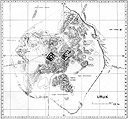Religion
Mesopotamia was a polytheistic society, that is, they believed that there were many gods who governed the various aspects of nature and civilization. From the earliest periods, each city in southern Mesopotamia had a patron deity and the inhabitants of a city would identify themselves as servants of that deity, either male or female. The cities were grouped into city-states with the capital of the city-state having the most prominent deity. Eventually, as the city-states came together to form a loose confederation, the gods were related to each other forming an extended family. Different traditions sometimes emerged; for instance, early on Inana, the patron deity of the city Uruk and the goddess of love, was considered the daughter of Enki, the patron deity of the city of Eridu and god of wisdom and craft. However, in another, probably later, tradition Inana was portrayed as the daughter of the moon-god, Nanna, of Ur.
During most of the third millennium, southern tradition held the god Enlil of Nippur to be the chief deity in the Babylonian pantheon, and in order to be considered legitimate rulers, kings had to be crowned in the city of Nippur as the religious capital. Northern tradition appears to have considered the sun-god, Shamash, as preeminent and his city Sippar the most important religious center. With the emergence of the Amorites as rulers, Marduk, the previously minor god of the city Babylon, began to rise in importance, eventually—late in the second millennium—becoming the head of the national pantheon.
Religious identities in Assyria, in northern Mesopotamia, differed somewhat from those in Babylonia. The chief deity of Assyria was the god Assur, identified with the early capital city, Assur. The rest of the Assyrian pantheon consisted mainly of the same gods as those in the Babylonian pantheon recast in Assyrian tradition. While scholars consider the Babylonians as the creators of what we think of as Mesopotamian culture, with the Assyrians as successors to many of their traditions, it is clear that Assyria developed its own strong traditions, and the two nations vied for political, military, and religious superiority throughout their history.

 Jennie Myers
Jennie Myers
Research Associate, University of Chicago
Guiding Questions
1. How did ancient Mesopotamian cultures reflect the concept of “assimilation”?
2. How did geographic factors, particularly mountains and bodies of water, factor into the blending, or, in some cases, the lack thereof, of cultures in ancient Mesopotamia?
3. How does the polytheism of ancient Mesopotamia reflect political, social, and economic systems based on family ties?


 Print Page
Print Page

